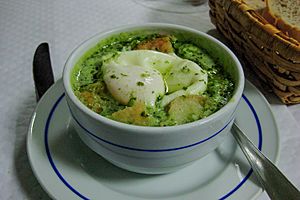Açorda facts for kids

Açorda à Alentejana
|
|
| Type | Bread soup |
|---|---|
| Course | Main course |
| Place of origin | |
| Associated national cuisine | Portuguese |
Açorda is a yummy and traditional dish from Portugal. It's like a special bread soup or a thick bread paste. The main ingredients are thinly sliced bread, garlic, fresh coriander, olive oil, vinegar, water, a pinch of salt, and poached eggs.
This dish can be a bit different depending on where you are in Portugal. For example, in a region called Alentejo, Açorda is often served as a soup. But in other parts of Portugal, it might be thicker, more like a bread paste. Sometimes, people add other tasty things like shrimps or codfish to their Açorda!
Making Açorda involves a few steps. First, eggs are gently cooked in salted water until they are "poached." Meanwhile, garlic, coriander, and salt are mashed together to make a rough paste. Then, olive oil and vinegar are mixed in. This flavorful mix is poured over the sliced bread. The poached eggs are placed on top. Finally, the water used to cook the eggs, often with some chicken stock, is poured over everything. The dish then steams for a few minutes. When it's ready, Açorda often has a bright green color from the coriander.
Where Did the Name "Açorda" Come From?
The name "Açorda" has a very old history, going all the way back to the Arabic language. The original Arabic word is tharada, which means "to break bread." In classic Arabic writings, you might find words like tharîd or tharîda. These words describe bread that has been crumbled and soaked in liquid.
The Portuguese word "açorda" actually comes from a special way of speaking Arabic that was used in the Iberian Peninsula (where Portugal and Spain are today). This was called Andalusi Arabic. The word they used was thurda or çurda, or sometimes thorda or çorda. The Portuguese word is very similar to these. Sometimes, the Arabic word "al" (which means "the") was added to the beginning, but it changed its sound, just like in Portuguese words like açúcar (from as-sukkar) or azeite (from az-zayt).
Açorda Through Time
The very first version of Açorda, called tharîd by the Arabs, can be traced back to the 5th century, even before Islam, in Pre-Islamic Arabia. It was a very important dish in Arab cuisine. People say that a person named Hāshim ibn ‘Abd Manāf was the one who first created this dish. This early Açorda was more like a stew with meat and pumpkin, and then breadcrumbs were added to it.
When Muslims arrived in the Iberian Peninsula in the early 8th century, they brought their thurûd dish with them. We know about thurûd from two old books. One is called FuDâlat al-Khiwân fi Tayyibât al-Ta'am wa-l-Alwân, written by Ibn Razîn al-Tujibî. The other is an anonymous book about Hispanic-Maghreb cooking.
One of the first times the word "açorda" appeared in Portuguese writing was in a play by Gil Vicente called Farsa dos Almocreves. He wrote: "Tendes uma voz tão gorda/ que parece alifante/ depois de farto de açorda" (You have such a fat voice/ that it seems like an elephant/ after being full of açorda). This shows that Açorda was already a well-known dish in Portugal a long time ago!


